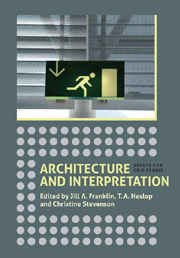Book contents
- Frontmatter
- Contents
- List of Illustrations
- Preface: In Appreciation
- List of contributors
- 1 Introduction
- Incitements to Interpret in Late Antique and Medieval Architecture
- Authors and Intentions
- Architecture beyond Building
- 266 Innovation and Traditionalism in Writings on English Romanesque
- 284 Why Medieval Ireland Failed to Edify
- 306 The Chapel of the Hospital of Saint-Jean at Angers: Acta, Statutes, Architecture and Interpretation
- 315 Sealed Architecture: City Seals, Architecture and Urban Identity in the Northern Netherlands, 1200–1700
- 333 Style and Geography: Struggles for Identification in the Later Nineteenth Century
- 343 The Dome of the Rock: From Medieval Symbol to Modern Propaganda
- 357 Towards a Cultural Geography of Modern Memorials
- 381 Bicycle Sheds Revisited, Or: Why are Houses Interesting?
- Index
315 - Sealed Architecture: City Seals, Architecture and Urban Identity in the Northern Netherlands, 1200–1700
from Architecture beyond Building
Published online by Cambridge University Press: 05 April 2013
- Frontmatter
- Contents
- List of Illustrations
- Preface: In Appreciation
- List of contributors
- 1 Introduction
- Incitements to Interpret in Late Antique and Medieval Architecture
- Authors and Intentions
- Architecture beyond Building
- 266 Innovation and Traditionalism in Writings on English Romanesque
- 284 Why Medieval Ireland Failed to Edify
- 306 The Chapel of the Hospital of Saint-Jean at Angers: Acta, Statutes, Architecture and Interpretation
- 315 Sealed Architecture: City Seals, Architecture and Urban Identity in the Northern Netherlands, 1200–1700
- 333 Style and Geography: Struggles for Identification in the Later Nineteenth Century
- 343 The Dome of the Rock: From Medieval Symbol to Modern Propaganda
- 357 Towards a Cultural Geography of Modern Memorials
- 381 Bicycle Sheds Revisited, Or: Why are Houses Interesting?
- Index
Summary
WHENEVER AND WHEREVER in the world settlements took on characteristics we now associate with cities, we can find architectural images that reflect the community's social, even emotional, priorities. One of the earliest is the wall painting reconstructed from a shrine at Çatal Hüyük (c. 6500 bc) representing a town plan with recurring rows of architectural units set beneath a black silhouette thought to represent an erupting volcano. It seems as if the orderliness of the man-made environment, the regularity of the city's layout and the neatness of the dwellings was intended to guarantee the transformation of the volcanic threat into an agricultural benefit. Instead of fearing being burned by lava, the community could enjoy the promise of soil fertilization.
With the development of cities and the intensification and complication of commercial and legal interaction within and between them, visible and tangible symbols of authority, legality and identity became a requirement. These materialized as flat objects about the size of a hand made of stone or metal (mainly bronze) carrying an image in sculpted relief. The image was to be printed on clay or wax and could be attached to a document for legal purposes or carried as a passport to avoid paying tolls. These items, now known as seals, were employed from the Neolithic period onward in Sumerian city-states, in Egypt, Mesopotamia, Iran, the Indus Valley and China, and were widely used in the Greco-Roman world. Individual cities often chose to represent themselves with architectural features considered to be distinctive of them, simultaneously reflecting and highlighting local preoccupations.
- Type
- Chapter
- Information
- Architecture and InterpretationEssays for Eric Fernie, pp. 315 - 332Publisher: Boydell & BrewerPrint publication year: 2012



